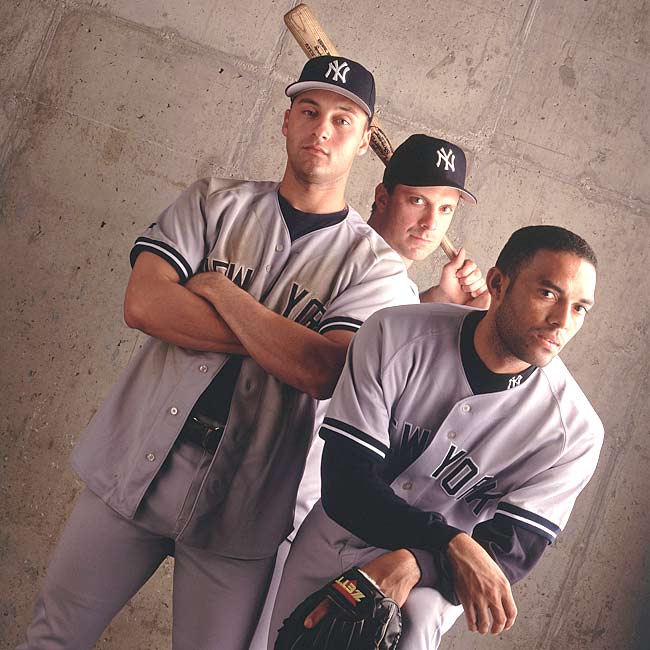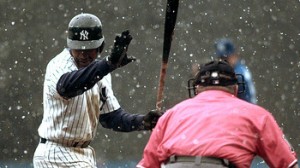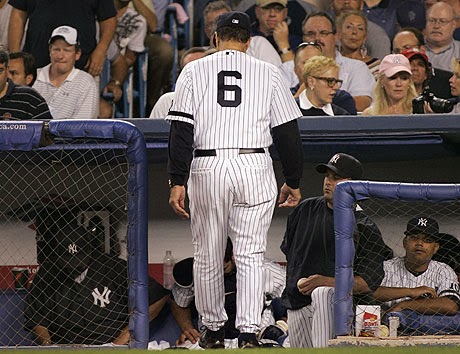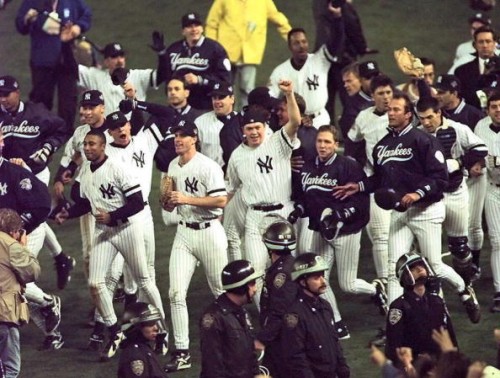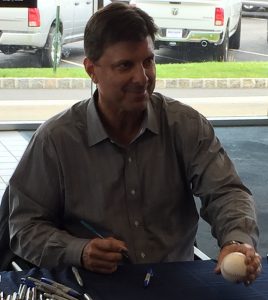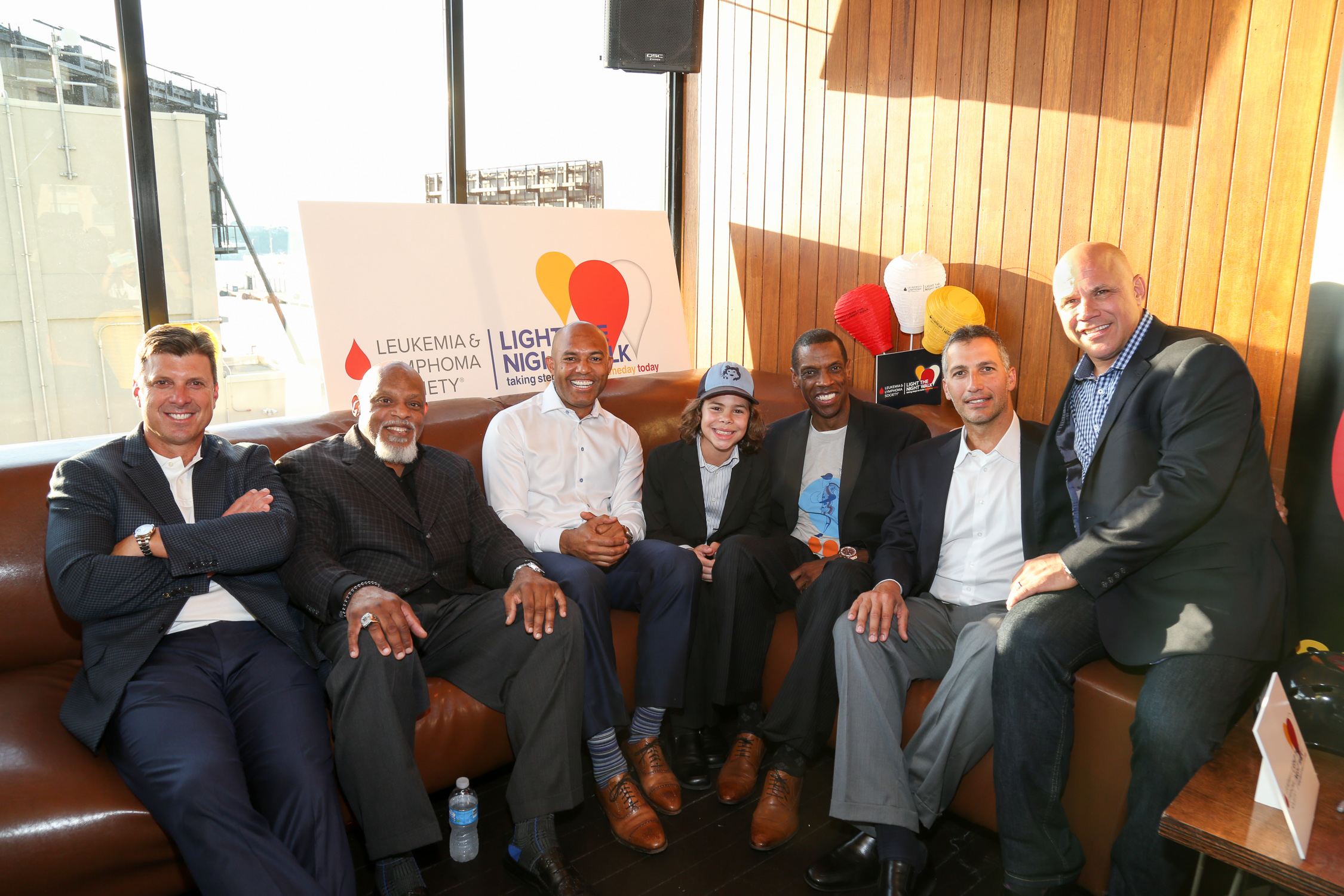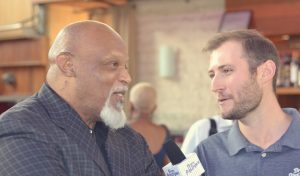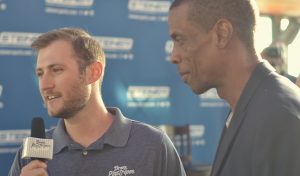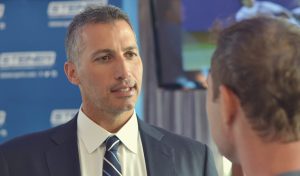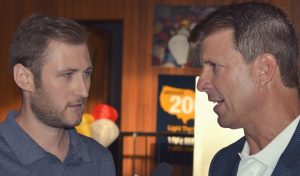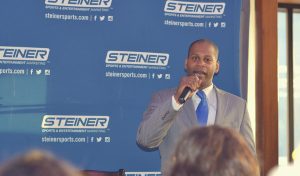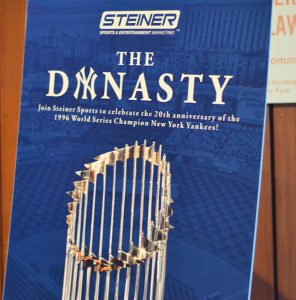This season will be the 20th anniversary of the remarkable 1998 Yankees championship team. The 2018 season comes on the heels of an unexpectedly successful regular season in 2017 that has fans looking forward to the coming year. But, before moving forward, it’s time to look back at one of the most remarkable teams in Major League Baseball history.
1997 Disappointment
Before the success of the ’98 campaign could take place, the Yankees had to get through the disappointment of the 1997 postseason. Looking to defend their 1996 World Series championship, the Yankees lost in the first round to the Cleveland Indians in the best-of-five Division Series.
The Yankees appeared to have things wrapped up with Mariano Rivera coming in to close out Game 4 in the ALDS. However, the Indians’ Sandy Alomar had other ideas and hit a game-tying home run. The Yankees lost in extra innings, 3-2, and then lost the finale, 5-4. The offseason mindset was full of “what ifs”.
The Long Winter
The Yankees’ front office quickly got to work for the 1998 season after coming up short in October. On November 7, the Yankees traded pitcher Kenny Rogers to the Oakland A’s for third baseman Scott Brosius. Rogers had been a major flop in the Bronx for a pair of seasons and put up an ugly set of numbers – 5.11 ERA, 1.497 ERA, and 4 BB/9 IP. Brosius was coming off of a season in which he hit .203/.259/.317. Just one year earlier, Brosius had set personal bests with a .304 average, 22 HR, 71 RBI, and a .909 OPS. The Yankees traded away Charlie Hayes and let free agent Wade Boggs walk, so they hoped for the best with Brosius.
In December, the Yankees added DH Chili Davis to the roster, and a month later re-signed free agent outfielders/DHs Tim Raines and Darryl Strawberry. And shortly before the team was set to report to Spring Training in February, the Yankees swung pitcher Eric Milton, infielder Cristian Guzman, outfielder Brian Buchanan, pitcher Danny Mota and cash to the Minnesota Twins for second baseman Chuck Knoblauch.
The 1991 AL Rookie of the Year, “Knobby” took home Gold Glove and Silver Slugger Awards, and was an AL All-Star selection in 1997. The Yankees wanted an upgrade over the ’97 crew of Pat Kelly, Rey Sanchez, Luis Sojo, and Andy Fox.
In early February, the Yankees also promoted Brian Cashman to General Manager.
A Slow Start
The sure-fire way to keep owner George Steinbrenner’s negative comments at bay was to win. Apparently, the ’98 squad didn’t get that memo. Opening on the West Coast, the Yankees dropped their first three games and four out of five. There were already rumblings that manager Joe Torre was in trouble. The team heard that warning loud and clear.
The Yankees won the final two games of the road trip and took six straight at home for an eight-game win streak. At 9-4, they sat a half-game back of the Baltimore Orioles in the AL East. The seventh victory took place in Shea Stadium against the Anaheim Angels.
A freak accident necessitated a shift of the Angels series to another venue. On the afternoon of April 14, a 500-pound chunk of concrete had fallen in Yankee Stadium. Thankfully, the game was still hours away, as the concrete landed on a seat and also damaged the concrete support beneath it. The Yankees and Angels played one game at Shea Stadium with the rest of the series postponed until August.
Here Come the Yankees
Despite typical chilly April weather in the northeast, the Yankees got red hot at the end of the first month of the season and moved into first place in the division. They took six of seven games from the Blue Jays and Tigers and then reeled off eight straight wins to improve to 23-6 (.793) on May 8.
In May, the Yankees put together winning streaks of three, four, and five games and exited the month with a 37-13 (.740) record. Second-place Boston topped the Yankees in back-to-back games after losing the first two games of a month-ending four-game series, but they were still 7.5 games behind the Yankees in the AL East. The rest of the division was disappearing faster than beers at the ballpark.
Rock ’em Sock ’em Robots
One factor that unified the team in May was a brawl that broke out between the Yankees and the Baltimore Orioles. After surrendering a three-run home run to Bernie Williams, Orioles closer Armando Benitez drilled first baseman Tino Martinez right between the shoulder blades.
Benitez then ignited an already tense situation and gestured to the Yankees’ dugout to “come and get me”. Both benches emptied, relievers raced in from the bullpen and a melee ensued. The two teams pushed and shoved, wrestled, and threw wild haymakers at one another. While some players and coaches tried to play peacemaker, the action spilled into the Orioles’ dugout. Strawberry landed a punch to Benitez and emerged with a bloody lip of his own. The league came down with an eight-game suspension for Benitez’s act of cowardice, and Martinez missed time with a sore back.
27 Up, 27 Down
On Sunday, May 17, David Wells took the mound at Yankee Stadium to face the Minnesota Twins. Attracted by a “Beany Baby” promotion, nearly 50,000 fans filled the seats. They were able to witness Wells at his very best…despite the fact that he was reportedly suffering from a hangover.
It took Wells just nine pitches to retire the Twins in order in the 1st inning. He breezed through the 2nd with 13 pitches and picked up his first strikeout when Ron Coomer swung and missed at strike three. After stranding a runner in scoring position in the home half of the 1st, the Yankees scored a run in the bottom of the 2nd on LaTroy Hawkins‘ wild pitch. Wells had all the run support he needed.
In the 3rd inning, Wells struck out the side, getting Jon Shave and Javier Valentin looking and got Pat Meares swinging. An inning later, Wells fell behind Matt Lawton 3-1 to start the inning before he retired him on a popup. 10 pitches later, he had retired all 12 batters he had faced in the game.
The Yankees tacked on a run in the bottom of the 4th on Bernie Williams’ solo home run and Wells dispatched the Twins quickly in the 5th with a pair of strikeouts and a groundout. Wells was halfway home to a perfect game and no-hitter. In the top of the 6th, Wells got Shave and Valentin again on strikeouts and Meares on a routine flyball.
“In the seventh inning, I started getting really nervous. I knew what was going on, I was hoping the fans would kind of shush a little bit. They were making me nervous.” – David Wells
Wells pitched into trouble in the 7th inning, with full counts on Brent Gates and Paul Molitor, but retired both on the sixth pitch of the at-bat to end the inning. With 21 straight retired, the tension in Yankee Stadium was palpable. It wasn’t’ much better for fans watching on TV or listening on the radio.
“I told him it was time to break out the knuckleball, he let out a big laugh. That told me he needed it.” – David Cone
Strawberry and Chad Curtis added an RBI each in the bottom of the 7th to give Wells a 4-0 cushion. Marty Cordova, Coomer, and Alex Ochoa worked 2-1 counts against Wells, but each was retired on the next pitch. 24 up and 24 down.
It couldn’t have helped Wells to relax in the bottom of the 8th when the Yankees put a man aboard and Twins’ manager Tom Kelly made a pitching change. When the inning finally ended, Wells strode out to the mound to face the 7-8-9 hitters in the Twins’ lineup.
Shave got into a 2-2 count before flying out to Paul O’Neill in shallow right field. Moments later, catcher Jorge Posada squeezed strike three in his glove as Valentin swung and missed. With the count 0-1, Meares lofted a fly ball towards the right field foul line. O’Neill deftly moved over from where he was stationed and recorded the final out of the game. He punched the air for emphasis as Wells and Posada embraced on the mound. They were quickly joined by their teammates who hoisted Wells up on their shoulders…no easy task.
Billy Crystal walked into the clubhouse after the game, approached David Wells and said, “I got here late, what happened?”
Wells’ perfecto was the Yankees first since Don Larsen in the 1956 World Series and it was the team’s first no-hitter since Dwight Gooden’s in 1996.
It is High, it is Far, it is Gone!
The 1968 baseball season became known as “The year of the pitcher”. One year after Carl Yastrzemski captured the AL Triple Crown and AL MVP Award by hitting .326 with 44 home runs and 121 RBI, “Yaz” was the only AL hitter to hit over .300. And he barely made it, leading the AL with a .301 batting average.
Flash forward to 1998, and an explosion of home runs in the Major Leagues. In the three decades between the offensively-challenged ’68 season and the barrage of offense in ’98, Major League Baseball lowered the pitcher’s mound, added the designated hitter in the AL, and increased the number of teams in both leagues. All of these factors tilted the advantage to hitters over pitchers.
On top of that, Performance Enhancing Drugs were being used by many more players than Commissioner Bud Selig and others (supposedly) knew. At the time, after the strike-canceled 1994 World Series, baseball had become fun again due to the uptick in home runs and the chase at Roger Maris‘ single-season record of 61 home runs.
Mark McGwire and Sammy Sosa made for an exciting summer that saw both players surpass 61 home runs and McGwire come out on top with a record 70 home runs. In addition, Ken Griffey Jr. (56) and Greg Vaughn (50) also topped the half-century mark. Nine more players hit between 40 and 49 home runs.
5,064 total home runs were hit, the first time in Major League history that the 5K total was reached. The Yankees hit 207 home runs in ’98, good for seventh in the Majors, but they finished first in run scored with 907. But the Yankees were much more than just an offensive machine.
The Emergence of El Duque
A rotation that featured David Cone, David Wells and Andy Pettitte could go head to head with any team. Imagine then adding another steady veteran to the mix, albeit an unproven one.
The story was told many times before Orlando Hernandez‘s June 3rd debut. “El Duque” left his wife and children behind in his native Cuba and took a boat to freedom. El Duque’s group was stopped by the Coast Guard in Bahamian waters and everyone aboard was detained. Eventually, agent/liaison Joe Cubas and the Cuban-American National Foundation convinced U.S. Attorney General Janet Reno to allow El Duque and some of the others into the U.S. on humanitarian (and athletic) grounds.
To hasten Hernandez’s MLB debut, fate interceded on his behalf. David Cone was bitten on the finger by his Mom’s dog. With Cone unable to pitch, the Yankees recalled Hernandez from the minor leagues. El Duque’s much-anticipated debut against the Tampa Bay Devil Rays went off without a hitch. He picked up his first Major League victory after he allowed a run on five hits over seven innings in a 7-1 romp.
Though not a true rookie, Hernandez finished fourth in the Rookie of the Year voting after going 12-4 in 21 starts. His 3.13 ERA, 1.170 WHIP, and 8.4 K/9 IP made him indispensable in the Yankees’ rotation.
Summer Heat
While much of the United States was focused on the McGwire-Sosa battle during the Summer, the Metropolitan area was talking Yankees baseball. The Yankees were firing on all cylinders to start the month of June, winning their first nine games to improve their winning percentage to .780.
The Yankees actually sputtered after that, dropping six of 11 games. No matter, they still led the AL East by nine games. They finished the month 56-20 (.737) and increased their divisional advantage back to 10 games. When the calendar turned to July, the Yankees blew the doors off, winning the first nine games of the month for an overall 10-game winning streak.
During the stretch, the Yankees outscored their opponents 52-23 with eight of their opponents’ runs coming in one game. Cone (3 wins), Pettitte (2), Wells, Hernandez, Mike Stanton, Hideki Irabu, and Mike Buddie all picked up victories along the way. In doing so, the Yankees’ winning percentage rose to 76.1%.
The Kid From Left Field
Back in 1998, there wasn’t a whole lot to read about on minor league prospects. So when Shane Spencer got a few cups of coffee (April, June, and July) in the Majors in 1998, the majority of fans didn’t know much, if anything, about him. Outside of a two-home run, five-hit game against the Royals in July, he was 4-24 (.167) and was returned to the minors for a third time on August 12.
But when the rosters expanded in September, Spencer pushed himself to the forefront with a blistering final month of the season. A 20th-round pick out of Granite High School in 1990, Spencer hit a solo home run on September 4. Two weeks later, he hit a grand slam.
On September 22, he hit a pair of solo home runs. The next day, he had three hits including a three-run home run, and the day after that he hit another grand slam.
After an 0-2 day at the park on the 25th, he came back the next day with a solo shot. He smacked yet another grand slam in the season finale. In 14 September games, Spencer hit eight home runs and drove in 21 runs. His splits for the month were .421/.476/1.105. That adds up to a 1.581 OPS in 42 plate appearances.
Down the Stretch
The final two months of the season were a cakewalk for the Bronx Bombers. On August 17, they extended their division lead to 20 games and they ended the regular season with a seven-game winning streak, easily winning the AL East by 22 games. To top it off, they broke the Cleveland Indians’ AL record for wins (111) with number 112 on September 25. The unlikely trio of El Duque, Pettitte, and Mariano Rivera dominated the Devil Rays in a 6-1 win.
The next day, the Yankees beat Tampa Bay again as Cone picked up his 20th win, marking the first time Cone accomplished that feat since he was a member of the New York Mets in 1988. Bernie Williams won the AL batting title with a .339 average and Derek Jeter topped the AL with 127 runs scored.
The acquisition of Brosius turned out to be a major coup. Had the Comeback Player of the Year Award existed back then, Brosius would have made a strong case for himself. He hit .300 with 19 home runs and a career-high 98 RBI. He also reached career-bests with 11 stolen bases, 159 hits, 86 runs scored, and a .472 slugging percentage. On top of all that he played outstanding defense and made it to his first and only All-Star Game.
The Postseason
The Yankees started the playoffs in fine fashion with a three-game sweep of the Texas Rangers in the best-of-five Division Series. The Yankees and Cleveland Indians then met for the second straight year, this time in the ALCS.
With the Yankees winning the opener, the team had an excellent chance to take both home games before heading to Cleveland. Cone pitched a superb game, but the Yankees trailed 1-0 until the 7th inning when Brosius’ RBI double tied the game. The teams battled to the 12th inning when the Indians put a man aboard to lead off the inning. Enrique Wilson pinch-ran and Travis Fryman looked to move him into scoring position with a sacrifice bunt.
Fryman laid down a beauty and ran towards first base. Martinez fielded the ball cleanly and attempted to throw to Knoblauch, who was covering the bag. Because Fryman was running in fair territory, Martinez’s throw clipped him in the back and ricocheted past Knoblauch.
Instead of chasing the ball down, Knoblauch began to appeal to the umpiring crew to call for interference. While his teammates and every Yankees fan in the Stadium yelled for Knoblauch to get the ball, Wilson stumbled his way across home plate with the go-ahead run. Torre argued, to no avail, despite the obvious incorrect call. The Indians tacked on two more runs for a 4-1 win and Knobby became a laughingstock.
The Indians won Game 3, putting the Yankees in trouble for the first time all season. They relied on El Duque to deliver them a money start and that’s just what he did. His masterful performance against former Yankee Dwight Gooden didn’t come without a first inning scare, however.
The Indians loaded the bases with two outs and slugger Jim Thome at the plate. Thome crushed a Hernandez pitch to right field and it appeared it would be a 4-0 Indians’ lead. But, the ball died at the outfield wall and fell into the glove of O’Neill, who had hit a solo home run in the top of the inning.
The Yankees won 4-0 and took the next two games, advancing to their second World Series in three years.
Lord of the Rings
The Yankees faced the San Diego Padres in the World Series, just the second time the Pads had won the NL pennant. Game 1 at Yankee Stadium was a wild classic. With the game tied 2-2 in the fifth inning, Tony Gwynn smacked a two-run home run off of Wells. Greg Vaughn, who had hit a two-run home run earlier in the game, followed with a solo blast to put San Diego up 5-2.
Meanwhile, Padres starter Kevin Brown limited the Yankees to two runs and five hits through the first five innings. But, with one out in the 7th, Posada reached on a single and Ricky Ledee walked. Padres manager Bruce Bochy called on reliever Donne Wall to face Knoblauch.
The Yankees’ second baseman entered the World Series in a 6-36 (.167) postseason slide, but hit Wall’s 2-0 delivery into the left field seats for a game-tying home run. Jeter continued the inning with a single and moved into scoring position on lefty Mark Langston‘s wild pitch.
Langston retired O’Neill, but after Bochy elected to intentionally walk Williams, Langston then issued a free pass to Chili Davis as well. That brought left-handed hitter Tino Martinez to the plate. Like Knoblauch, Martinez entered Game 1 in a major postseason slump (5-30). With the count even at 2-2, Langston delivered a pitch that determined the direction the Series would take.
Martinez froze on Langston’s slider for what appeared to be a called third strike to end the inning. But home plate umpire Richie Garcia called the pitch a ball. Moments later, Yankee Stadium exploded with sound as Martinez drilled Langston’s pitch into the upper deck in right field for a go-ahead grand slam.
After a 9-6 final in Game 1, The Yankees romped in Game 2, 9-3. Back at their home park, the Padres got three runs early against Cone, and ex-Yank Sterling Hitchcock blanked the Bronx Bombers through six innings. In the 7th inning the Yankees scored a pair of runs, one of them on a Brosius home run.
Down 3-2 in the top of the 8th, Brosius crushed a three-run home run to dead center field off of All-Star closer Trevor Hoffman. The Yankees held on for a 5-4 win and a 3-0 lead in the Series.
Game 4 was a microcosm of the Yankees season – great pitching, hitting, and defense. Pettitte (7.1 IP), Nelson (0.2 IP) and Rivera (1 IP) combined on a 3-0 shutout. Brosius drove in another run, and captured the Series MVP Award and fittingly fielded the final out of the ballgame.
The Yankees won 11 games in the postseason for a total of 125, and to this day they are compared to the greatest teams of all time.
The post 1998 Yankees: One of the all-time teams appeared first on Bronx Pinstripes | BronxPinstripes.com.
